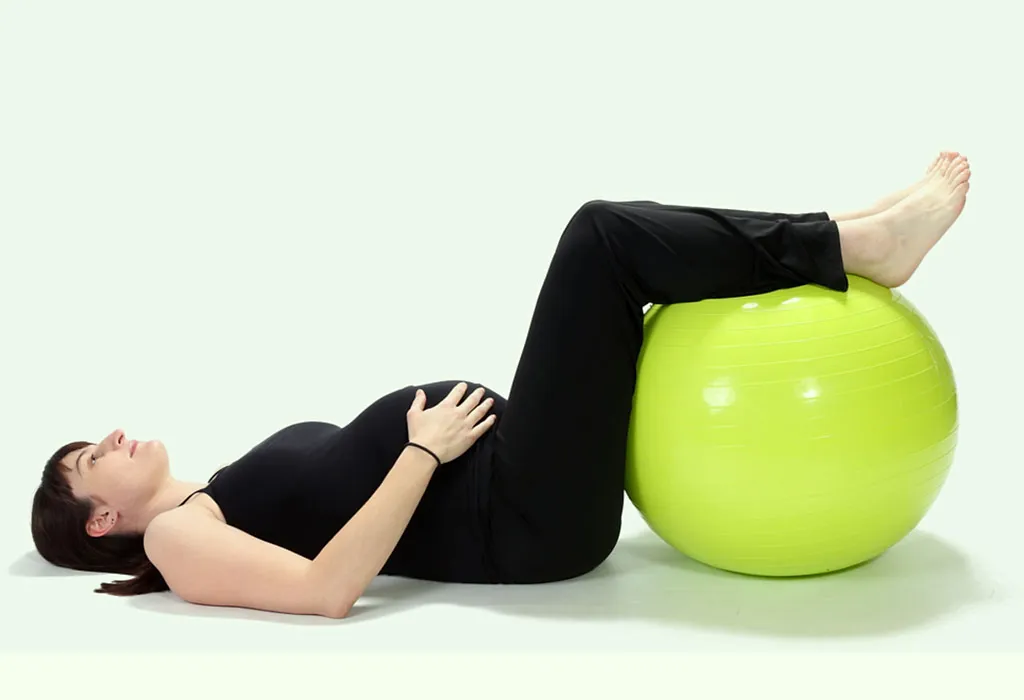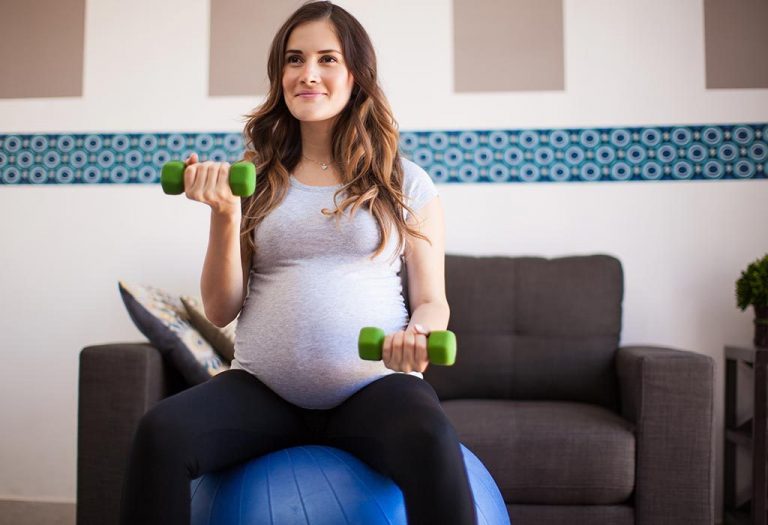Birthing Ball – Benefits, Exercises and Uses
Learn how birthing ball helps ease labor pain improve posture support gentle movement and prepare your body for smoother delivery
If you are wondering about effective ways of exercising and dealing with labour, you would be glad to know that birthing balls are a boon for a mother-to-be. You may have seen these giant inflated balls in the gym, in your yoga class, or during one of the antenatal visits at your doctor’s clinic. A birthing ball is not only effective during the birthing process, but these vinyl balls may also help you sail through your pregnancy. In this article, we will discuss how you can use a maternity exercise ball efficiently and derive maximum benefits from it. Let’s begin with understanding what a birthing ball is and what its benefits are.
What Is a Birthing Ball?
A birthing ball or a birth ball is a kind of an exercise ball that can be used during pregnancy, labour, and even after birth. These rubber balls can be used in many ways, including during pregnancy and later (1).

When to Start Using Birthing Ball?
You can begin using a birthing ball as early as the first trimester, but many women find it most helpful during the second and third trimesters. As you approach the later stages, especially from 32 weeks onwards, a birthing ball can help prepare your body for labour by encouraging the baby to move into the optimal position for birth and relieving pelvic pressure.
Benefits of Using a Birthing Ball
A pregnancy ball has many benefits and may help you in several ways during pregnancy. Here are some of them (2):
- It helps ease your back pain and thus makes mobility easier during pregnancy.
- It helps increase blood flow to your pelvic region (uterus and placenta).
- It helps in reducing spinal pressure.
- It helps in giving counter-pressure to your thighs and perineum.
- It helps in providing excellent support to your ankles and knees.
- It helps you to be in an upright position and thus works efficiently with gravity for your baby’s descent.
- It helps in opening the pelvic muscles.
Some women may feel dizzy while using a birthing ball. If you feel any dizziness, refrain from using it.

Let’s get to know a little more about birthing balls.
Difference Between a Birthing Ball and a Gym Ball
Gym ball and pregnancy can go well together when the ball is used gently for comfort, posture support, and light movement. A birthing ball and a gym ball are more or less the same. Both these balls are made of an anti-burst material, which means they wouldn’t burst at one go on being punctured but deflate slowly. These balls should be kept from sharp objects, direct heat or rough surfaces. The only features that differentiate a birthing ball from a gym ball are:
- Gym balls are comparatively smaller than birthing balls.
- Most birthing balls come with an anti-slip finish.
- Some birthing balls are round, while some are in the shape of a peanut to allow using it while lying in bed.
Which Birth Ball Should You Buy?
You should buy a birth ball according to your height, which means if you sit on the ball, your feet should touch the floor comfortably. We shall talk a little more in detail about the size of the ball shortly. When you select one, you can opt for one with an anti-slip finish and anti-burst features. Also, make sure you buy a ball that can take your weight. A birth ball meeting these criteria is a good purchase to ease pregnancy, labour, and childbirth.

Maternity ball covers are also readily available. If the store owner offers one, consider buying it for the reasons below.
Why Do You Need to Buy a Birthing Ball Cover?
You need to buy a birthing ball cover because of the following reasons:
- The cover makes it easier to carry the ball from one place to another.
- The cover helps to keep the ball clean.
- The cover helps to manage the ball effectively.
- The cover makes the ball feel soft against the skin.
- The cover makes the ball look pretty, and you can keep changing the covers for a new look if you get bored with it.
How to Choose the Size of the Pregnancy Ball?
As mentioned earlier, your appropriate ball size can be determined based on your height. The following table will also help you ascertain the right size of the birthing ball for you (3):
| Your height | Recommended Ball size |
| Less than 5 feet 4 inches | 55 centimetres |
| 5 feet 4 inches to 5 feet 10 inches | 65 centimetres |
| 5 feet 10 inches or taller | 75 centimetres |
It is recommended that you buy a high-quality birthing ball or one from a renowned brand. Most balls are pressure-tested and can easily support weights up to 300 kilograms.
It is a good idea to buy a pump along with your birthing ball, as most balls do not come with one. It is common for the ball to lose air when used regularly. With a pump, you may fill the air as and when needed.
The next question many expectant mothers have is how to use the birthing ball. Well, most of the time, you buy a birthing ball only after an expert advises you to. The expert would also guide you through and teach you the best and the safest ways to use the ball. Nonetheless, here are some ways to be prepared to use the ball for the first time.
How to Use a Birthing Ball for the First Time?
If you are using maternity or birthing ball for the first time, the following tips may prove to be useful for you (4):
- Place the ball on a rug or a carpet rather than placing it on the floor. You can be barefoot or use anti-skid shoes. You may ask someone to help you to sit while supporting the ball from behind.
- Balance your body by placing your feet firmly on the ground and keeping them apart (almost 60-70 centimetres).
- Place your hands on your knees to get comfortable as you sit on the ball. Rock sideways or back and forth. Once you secure your position, bounce gently.
- If you do not feel confident with the bouncing or rocking movement, you may place a chair close to you and use it as support.
- If you wish to use the ball for exercise, make sure there is ample space in the room to place it. You should keep your movements slow and steady and stop when you feel uncomfortable.
You already know that the birthing ball can be used at any stage of pregnancy and after childbirth if an expert advises it. But what are its uses? Let’s find out!
Uses of Birthing Ball
You can use your birthing ball during pregnancy, labour, and after childbirth. Read on to learn its uses.
1. During Pregnancy
During pregnancy, a birthing ball can strengthen the pelvis, the lower back and the leg muscles. If exercising is not always possible, you can comfortably sit or relax on the ball rather than using a chair, couch or sofa. A gentle rocking exercise will prepare you well for childbirth, too. You may move back and forth or sideways. In the later months of pregnancy, you may also use the birthing ball to change your baby’s position. In case your baby is in a posterior position, the forward-leaning and upright positions may help your baby change position (5).

2. During Labour
Similarly, the birthing ball can come in handy during labour, too. You may lean on the ball for support or sit on it, rocking front or sideways as you experience the contractions. The curve of the birthing ball provides good support and puts gentle pressure on the engorged vagina during labour. The ball also provides good mobile support, especially to the upper body. Having said that, it is very important that you are comfortable using a birthing ball before using it for labour (6).

3. After Childbirth
After childbirth, a birthing ball can be useful for sitting as it provides a comfortable shape and feel to sit on as compared to sitting on a hard surface due to the soreness that remains for a few days after childbirth. Once you get the hang of the ball and can balance your weight, breastfeeding your baby can be very convenient and comfortable, too. You may even rock and soothe your crying baby while sitting on the ball. It is perfect for exercising and helps you tone up and lose pregnancy fat. It can be used for sitting, even in the office. When your child grows, you may help your baby stand, walk or scoot with your birthing ball.
We mentioned exercising using the birthing ball in the article above a couple of times. But swaying and rocking are not the only exercises that can be done on it. Read on for more ways to exercise on the birthing ball.
Exercises to Do With a Birthing Ball
A birthing ball is extremely beneficial for exercising in pregnancy. You may also use birthing ball exercises to induce labour. Following are some of the exercises that you may do with your birthing ball:
1. The Bouncing Exercise
Bouncing gently on a birthing ball helps in strengthening your legs and your balancing ability. You can perform this birth ball exercise to induce labour.
2. The Pelvic Tilt Exercise
Place your birth ball against the wall and sit with your back touching the ball. By pulling your tummy in a little, gently curve your lower back and push it towards the ball. This is a good way to strengthening your lower back and uterus.
3. The Hula Hoop Exercise
You need to sit firmly on the ball with your hands resting on your hips. You should make large circular movements with your hips, just like hula hoop dancers do. This is a great exercise for your pelvic floor and your thighs.
4. The Resting Child’s Pose
You will be required to kneel on the ground with the ball held in front with both your hands. Then, slowly roll the ball forward and bend as much as possible using the ball as the support. This pose strengthens the lower back, the arms, the shins, and the calf muscles.
5. Ball Lift
This is a great exercise to tone your arms and stretch the spine. Stand with your feet apart, holding the ball in both your hands. Stretch your hands and slowly lift the ball over your head. Then, slowly lower your hands and bring the ball in front. Do this a couple of times, ensuring your back is straight and your feet are firm on the ground.
Note:- If you want to practice these exercises, you must first learn them from a specialist and make sure you do them under supervision. Ask your husband or caregivers to support you while you do them.
If you are concerned about using a birthing ball, you must consult a specialist who can help you. Here are some more tips that will be useful when using a birthing ball.
Tips to Use a Birthing Ball Safely
Following are some tips on how to use pregnancy ball or labour ball safely:
- It is important to choose a ball with a non-bursting feature. This feature ensures that the ball does not burst suddenly.
- Make sure to buy the right ball size for you (according to your height).
- Always move carefully on the ball.
- Buy a ball that has a non-slippery or anti-skid surface.
- Place your hands on the ball to keep it steady before sitting.
- Keep a safe distance between your feet so you do not go off balance or slip.
- It is better to sit barefoot on the ball or wear good anti-skid footwear to avoid slipping.
- Never hold your breath sitting on the ball. Inhale through your nose and exhale through your mouth.
- It is recommended that you use the birthing ball under supervision for the first few times before you get a good handle on it.
FAQs
1. Is using a birthing ball safe for all pregnant women?
Generally, using a birthing ball is safe for most women. Still, it’s always best to consult your doctor, especially if you have any specific conditions like pelvic pain or are at risk of preterm labour.
2. How can I use a birthing ball to improve my posture during pregnancy?
Sitting on a birthing ball instead of a regular chair encourages you to maintain a more upright posture. It helps engage your core muscles, improves balance, and reduces slouching, which can lead to back discomfort.
3. Can a birthing ball help with swelling in the legs and feet during pregnancy?
Using a birthing ball to do gentle exercises like rocking or rotating your hips can improve blood circulation, which may help reduce swelling in the legs and feet.
4. How often can I use a fit ball for pregnancy?
A birthing ball can be used daily for short sessions, whether for sitting, stretching, or light movement. Some people replace their chair with a birthing ball for part of the day to maintain active sitting and reduce stiffness.
5. Is a yoga ball for pregnancy the same as a birthing ball?
A yoga ball and birthing ball are very similar. Both are large, anti-burst exercise balls, though birthing balls may be slightly thicker and sized specifically for pregnancy and labour use.
6. Can an exercise ball for pregnant women be used after birth?
Yes, a birthing ball can be helpful postpartum for comfortable sitting, supporting gentle core exercises, and easing back tension. Its soft, flexible surface can make sitting more comfortable during recovery.
7. Is a Swiss ball the same as a physio ball, and can it be used during pregnancy?
A Swiss ball and a physio ball are essentially the same type of large, anti-burst exercise ball. During pregnancy, both can be used for gentle stretching, posture support, and light mobility exercises, making them versatile tools for comfort and stability.
A birthing ball is a great way of staying fit during pregnancy. It can ease your labour woes and has ample benefits even after your baby is born. However, it is recommended to master the technique of using a birthing ball before using it for labour. Be always cautious while using a birthing ball to avoid accidents or mishaps. The best way to do that is to have someone with you to support you or the ball every time you use it.
Also Read:
Water Birth Delivery
Best Positions to Try During Labour and Delivery
Tips on How to Prepare for Labour & Childbirth
Using Peanut Ball for Labour And Delivery
Was This Article Helpful?
Parenting is a huge responsibility, for you as a caregiver, but also for us as a parenting content platform. We understand that and take our responsibility of creating credible content seriously. FirstCry Parenting articles are written and published only after extensive research using factually sound references to deliver quality content that is accurate, validated by experts, and completely reliable. To understand how we go about creating content that is credible, read our editorial policy here.






















